This post, a follow-up to my earlier posts “La longue purée” and “Jo Guldi’s Curiouser & Curiouser Footnotes“, examines the recent revisions made to The History Manifesto. Warning: the post may be tedious. For die-hards only.
Recapitulation
In October 2014, The History Manifesto was published as an open-access book by Brown and Harvard historians Jo Guldi and David Armitage. In the book I discovered numerous errors and bizarre interpretations of research in economics and economic history, which I publicised through this blog. The most egregious of the errors have now been edited. Almost all of the revisions pertain to parts of the text and notes that I was the first to notice and attack as outright errors. See this page for the original version, the revised version, and the list of revisions.
My primary purpose in “La longue purée” and “Jo Guldi’s Curiouser & Curiouser Footnotes” was to demonstrate that Guldi and Armitage are rankly incapable of understanding social science research ; and that their activist inclinations incapacitate them from reading it dispassionately. That is why The History Manifesto is so full of errors, distortions, and misrepresentations of that research. That alone, in my opinion, undermines the central argument of their book.
My posts got far more attention from historians than from economists, most of whom would not bat an eyelid even if accused by historians (or sociologists) of being cannibalistic perverts. I certainly never expected I would be cited in The American Historical Review [PDF version] or linked to by The Chronicle of Higher Education [PDF version].
The latter article reports on a controversy stirred up by the revisions. I believe I was the first to alert people to them on Twitter, but I do think the ethical angle has been overblown. I’m only interested in what the revisions reveal substantively.
(1)
Jo Guldi herself has called the revisions “ten lines of tightened prose and five revised footnotes”. But all “five revised footnotes” involve the elimination of previously cited works and substitution of alternates. The expurgation of Kenneth Pomeranz in favour of James C. Scott, for example, seems like a tacit admission that neither Guldi nor Armitage had much idea what was contained in the works originally cited. In fact, I think that’s true of many more citations than have been revised.
At the end of her post, Guldi alludes to me obliquely :
[Edit: at a different blog, she cites me directly.]
My judgement is vindicated by Guldi’s and Armitage’s own actions. But besides outright errors, I also pointed to distortions and misrepresentations, i.e, not errors of fact, but bizarre interpretations due either to poor comprehension of the source material, or possibly to never having read the haphazardly dumped citations at all.
A major example of bad interpretation that I cited in my footnotes post but which was left intact in the revisions is Guldi’s exposition of the work of environmental historian Paul Warde. Perhaps he’s equally “unfamiliar with the conventions of writing in the historical profession” or perhaps he just did not realise his mention was but a suggestion “for further reading” :


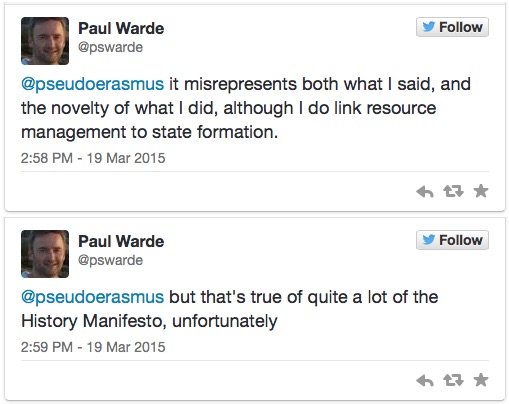
(2)
Below I examine the “ten lines of tightened prose and five revised footnotes”. Contrary to that characterisation, most of the revisions are in fact hasty, jerry-rigged patches to cover up embarrassing errors. Nonetheless, the patches often make the meaning of the text less tight and in some cases more nonsensical.
Note 30 on pg 144, pertaining to text on pp 70-1
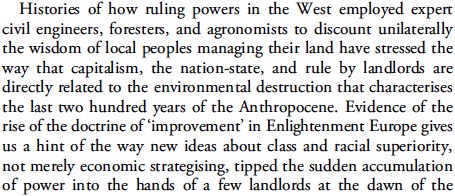

Original Revised
Revised
The reference to The Great Divergence was surrealistic given the content of the passage, but it has now been replaced by Seeing Like a State. This substitution is the least objectionable of all the revisions, but it’s still a tendentious choice. Scott’s book is definitely about how “ruling powers… employed… experts… to discount… the wisdom of local peoples”, but it’s generally not about capitalism. Some of Scott’s most prominent examples include the the Soviet collectivisation of agriculture and Julius Nyerere’s “villagisation” of Tanzania. There are a few “capitalist” examples in the book, such as the origins of the German forestry service or the creation of agricultural monocultures. Scott does also argue à la Polyani that the expansion of markets destroys local culture and knowledge — but as an afterthought. The book is primarily a quasi-anarchist or anarchosocialist polemic directed against central planning. In other words, it is an argument within the left.
So it’s odd that a supposed specialist in land movements could not come up with a better example to replace Pomeranz…
Note 54 on pg 138, pertaining to text on pp 57-58:
Original
Revised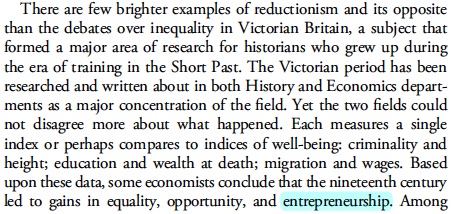


The original word “nutrition” was hastily replaced with “entrepreneurship”, and it’s as though a liver transplant patient had received a baboon pancreas and the surgeon stitched him up with twine.
Apparently Guldi scrambled to find a Joel Mokyr reference that would fit her passage concerning inequality, poverty, nutrition, and other aspects of Victorian living standards that economists and historians are alleged to view so differently. But Mokyr’s “Entrepreneurship and the Industrial Revolution in Britain” has nothing to say about those issues. It certainly does not argue entrepreneurship was anything but an elite activity, involving at most a couple of thousand people in the relevant period.
Far from focusing on a “single index” of anything as Guldi accuses economists do, Mokyr ranges widely in a sociological-psychological-economic investigation of entrepreneurs — from their “genteel” aspirations and the culture of the gentleman; to norms and codes of conduct in the presence of weak legal institutions; to a quantitative investigation of the financial risks and rewards for entrepreneurs. In other words, it’s precisely the opposite of Guldi’s caricature of economistic reductionism.
The citation of Godley & Casson’s essay “The History of Entrepreneurship in Britain 1900-2000” perpetuates the Guldian tradition of attributing to a source the opposite of what it said. G & C attempt to mitigate the blame traditionally assigned to British business for Britain’s “industrial decline”, and they do partly blame government policy: tariff protectionism before the war, and the expansion of the state sector after the war. Nonetheless, Godly & Casson’s essay scarcely implies “socialism” found a situation of improving equality, opportunity, and mobility and transformed it into one of stagnation. To the contrary, their description of entrepreneurial opportunity in the early 20th century could be embraced by Guldi herself :
Finally, the continued inclusion of Jason Long’s two articles in the note still constitutes gross misrepresentation of their contents. See “Jo Guldi’s Curiouser & Curiouser Footnotes“.
Note 60 on pg 139, pertaining to text on pg 59
Original
 Revised
Revised
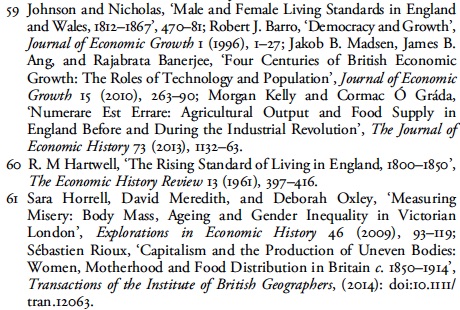
Johnson & Nicholas had been cited three times in the original History Manifesto, each a case of manifest error. Now J&N has vanished altogether from notes 54 and 60 of pp 58-59. Note 59 remains unchanged, but now you can never learn from the book itself the first names of the desaparecidos…
The J&N citation of note 60 has been replaced with Hartwell 1961, an ancient reference which is barely cited today, the debate on English living standards in the first half of the 19th century having advanced far beyond this primitive paper.
Instead of the prose merely being “tightened”, the lazy substitution of Hartwell 1961 actually introduces a different ilk of nonsense into the text. Guldi had originally juxtaposed Johnson & Nicholas and Horrell et al. — both studies of the physical condition of Victorian prisoners — in order to illustrate the alleged contrast between reductionist-freak economists and those broader minds edified by social historians — except the two papers are in agreement.
Now the new juxtaposition doesn’t even make sense as bad contrast. Hartwell 1961 mentions neither height, nor weight, nor (!!!) prisoners. And there is no discussion of earnings in 1812 let alone in 1867, which is outside the time frame of the article. Hartwell does argue wages and living standards must have been rising in the 1800-50 period. But then he spends the last three pages qualifying that life was nonetheless not all that great in 1800-50 !
By the way, R. M. Hartwell is still not an American.
Note 9 on pg 141, pertaining to text on pg 63
A densely populated note which was comically unrelated to the substance of the text, has been genocided and a demographic replacement has taken place. The citations are still totally inappropriate as support for the text, even if they are now merely dull rather than comical.
Guldi’s comments about Grossman & Krueger are simply incorrect. She cannot have read that article or at least could not have understood it. The G&K paper is not about climate change, having explicitly excluded “air pollutants that affect the global atmosphere, and specifically those that contribute to ozone depletion and to the greenhouse effect” (pg 356). Their main claim is that in a sample of countries from the 1960s/70s to the 1990s (not since 1700!), specific environmental indicators eventually improved as GDP per capita grew. But Guldi apparently never read past the gotcha on page 1 of the working paper version, where G&K are caught red-handed showing faith in new technologies. Yet they also note on pp 371-2 :
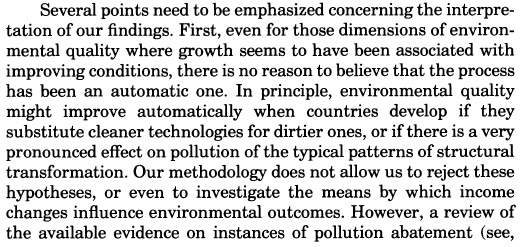

The negative statistical association between income and pollution over time is likely due to an “induced policy response”, i.e., people eventually demand action on pollutants. There is absolutely no justification for Guldi’s interpretation that these economists are saying the “invisible hand of the market would take care of them all”. That’s just a childish reading. Yet there’s more :
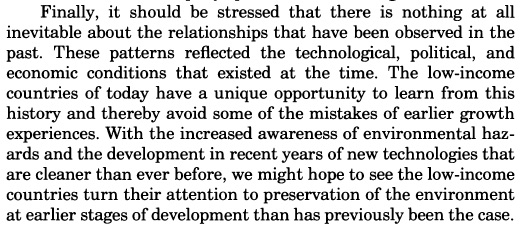
So G & K’s “own version of the past and future” suggests developing countries are not bound by the past of the developed countries. The past does not fix the future. That’s actually consistent with what Guldi and Armitage argue throughout The History Manifesto !
Unbelievably, Shafik is even less appropriate than Grossman & Krueger for Guldi’s purposes. Shafik, which did test for carbon emissions, found much more mixed results than G&K: some “environmental indicators improve with rising incomes (like water and sanitation), others worsen and then improve (particulates and sulfur oxides) and others worsen steadily (dissolved oxygen in rivers, municipal solid wastes, and carbon emissions”. But like G&K, Shafik is far from championing the idea that the free market will automatically take care of environmental problems :
Once again, the complete opposite of Guldi’s characterisation. Is there anything she gets right ? Maybe Bjørn Lomborg who’s cited above ? Not even him. But I will get to that at the end.
Note 18 on pg 142, pertaining to text on pg 66
Original
Revised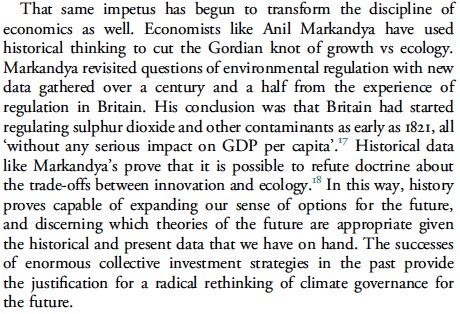

Guldi excised Kenneth Arrow and doubled up on David I. Stern as “suggestions for further reading”. But what does she have against the energy & environmental economist anyway ? Is she aware that Stern’s model of energy in economic growth is an important element of a book approvingly cited by her [pg 143, note 19] ? Nonetheless it seems Guldi believes Stern’s two papers represent “doctrine about the trade-offs between innovation and ecology”.
The previously cited papers by Grossman & Krueger and by Shafik looked for evidences of the Environmental Kuznets Curve, the proposed inverted U-shaped relationship between per capita income and environmental degradation. The hypothesis holds that starting from a low income base, environmental quality deteriorates at first with growth, hits a peak, and then starts improving. The EKC does not, however, hold that the market necessarily accomplishes this automatically. In fact, the EKC might be described as a theory of people’s political demand for environmental quality.
The two papers by Stern, however, are sceptical of the very existence of the EKC ! Stern & Common 2001 asks whether the turning point in the EKC for sulphur emissions has not been underestimated in the literature by the use of data samples restricted to developed countries. When a larger sample including developing countries is analysed, the income at which sulphur emissions per capita begins to fall is very high, i.e., effectively, there is no EKC for sulphur. Stern 2004, disputing previous studies which found a robust EKC relationship, note that developing countries often adopt environmental standards and regulations earlier in their growth trajectory than had been the case for the now developed countries.
(3)
In all this time, Guldi has not come up with a single example of an economist who has argued the “invisible hand of the market” will take care of climate change. Not a single one. Which only makes sense because it’s unlikely such a creature exists. That’s where her inclusion in that club of Bjørn Lomborg (who is not an economist by the way) is revealing.
The Skeptical Environmentalist sprawls across a megaplex of environmental topics, but on climate change, the view is unambiguously not that “no matter what dangers had recently been revealed by climate science, the invisible hand of the market would take care of them all”. Rather, Lomborg’s book argues the cost of measures to reverse climate change could very well exceed the benefits from doing so; or that a cost-benefit analysis may reveal there might be more important priorities than climate change. What ever one thinks of that argument, it is definitely not “the market will take care of climate change”.
Here’s a theory about why Guldi has persistently misrepresented the role the market plays in economists’ analyses of the environment: she is irredeemably confused about two superficially similar but distinct ideas. She has probably read somewhere that economists typically do not think the depletion of resources like petroleum, etc. is a major problem as long as the price mechanism is allowed to work. When oil becomes scarcer, the higher prices induce innovations in energy substitutes or energy-saving technology, and encourage the exploration for new sources or exploitation of sources which would have been uneconomical at lower oil prices. I think it’s fair to say most economists agree with Julian Simon, contra Paul Ehrlich, that the price mechanism works, not perfectly, but reasonably well to prevent resource depletion.
It does not follow, however, that this logic necessarily extends to pollution and climate change. In the case of depleting resources like oil or industrial minerals, the costs are (in most cases) internalised in the prices paid by consumers. In the case of pollution, the costs are (mostly, depending on the kind) externalised — paid by other people — so the individual incentive is often to “consume” more pollution.
Even if Guldi thinks that’s a lot of bollocks, she might have still looked up “externalities” in Wikipedia if only to know what economists actually think and only then dismiss the concept.
(4)
Finally, Mark Koyama, whose review of The History Manifesto I recommend, has flagged another environment-related error by Guldi that I did not initially catch :

I will explain it even more simply. Zero time discount rate => the well-being of future generations is treated as equal in importance to the well-being of the current generation. Positive time discount rate => the well-being of future generations is reduced or “discounted” relative to the well-being of the current generation. So, yes, Guldi garbled William Nordhaus’s critique of the Stern Review.
“Social time preference” is such a fundamental concept in the economics of the environment that anyone who doesn’t know what it is, has no business having opinions on the subject.
Edit 14-04-2015: One howler from the original History Manifesto that carried over to the revised version that I forgot to call attention to both times is this gem from page 109:
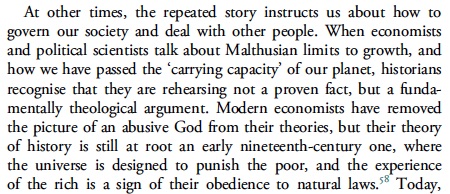
Because, you know, the one thing economists are known for is jabbering about the limits to growth and the planet’s carrying capacity ! Besides, I thought economists were supposed to be market-utopian techno-optimists ? I believe Guldi confuses the Malthusian model of economic historians, which ceases to operate with the Industrial Revolution, with the Malthusianism of the ecologists, a totally separate beast. I think this confirms that Guldi can’t even get stereotypes right… or keep her own straight.
Edit 14-04-2015: Jo Guldi, who now has multiple blogposts about her experience with publishing The History Manifesto, uttered this in her latest :
“It was me, the untenured member of our writing collaboration, who was targeted by an anonymous twitter personality for his original attack, on the grounds that due to her relative inexperience, it was she, not her senior collaborator, who must have been responsible for any errors in the text.”
Again, that reading problem. No, I did not single her out for those reasons. In a note appended near the end of the blog post “Jo Guldi’s Curiouser & Curiouser Footnotes“, I explicitly stated why I reckoned Guldi was the author of the difference between The History Manifesto and the precursor article that had appeared in Annales. [Edit 15-04-2015. Correction: I had read this earlier version of the draft that is forthcoming in Annales.]
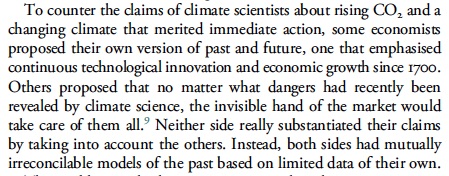
 Revised
Revised
Great line: “A densely populated note which was comically unrelated to the substance of the text, has been genocided and a demographic replacement has taken place.”
LikeLike
This blog is one of the most stimulating places on the web for a detail-freak like myself to hang out. I love it. Both for the posts/discussions and for the pointers to things worth looking into.
“The History Manifesto” was one of those pointers. I found out about it from this site. I bought (sic) and enjoyed the book. I found it hilariously inept in spots, as you did, and perhaps even more in the large than the small. Heck, how do you rant, constructively, about history’s approach to “global warming, growing inequality, academic specialization, and short-term thinking” – all at the same time?
In particular the short-vs-long emphasis was unfortunate. There is no correlation between the scope of a historical study and the human tendency to under-consider the long-term consequences of everyday decisions. Though it mimicked the structure and approach of Braudel’s famous “combat”, The History Manifesto suffered hugely by this self-chosen comparison.
But in the end the book made one point well worth pondering: it is urgent for historians to demonstrate the contingency of the past in order both to arouse people from a sense of hopelessness and inevitability and to empower them to “take on” an equally contingent future. It is an important takeaway and a point that Braudel would have endorsed (see the conclusion to “Civilization and Capitalism”). .
Now, whether or not the authors, as you say, are “rankly incapable of understanding social science research” (one does have to ask, what social scientist would have taken on four such impossibly confounding themes as these?), it’s a shame they didn’t show a keener appreciation (again, like Braudel) of the strengths of rival disciplines or provide better evidence of the “nuanced” contributions that historians can make in parallel to economists and social scientists. Some of their citations, however, do point to writers who may exemplify some of the The History Manifesto’s claims. (Andreas Malm’s papers and forthcoming book on “Fossil Capital” are a case in point – it’s the kind of challenge to the “dominant narrative” that scholars like Mokyr and Allen will find well worth evaluating.)
Bottom line: I wish The History Manifesto were a tighter book, but I was still moved by it.
Finally, I agree that it is hard not to see Guldi as looming larger than Armitage in this “collaboration”. And the collaborators have now begun to speak individually. So it’s fine, now, to take on Guldi directly – you have flushed her out, so to speak. But “Errata dentata”, as the title for a post, seems to go too far.
LikeLike
Well, my original title idea was “Farrago est corrigenda” but that seemed obscure.
LikeLike
But “farrago” would have been much better – each of its possible meanings conveys a different insult!
LikeLike
Reblogged this on muunyayo .
LikeLike